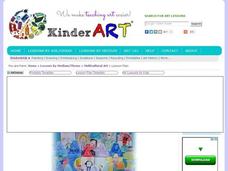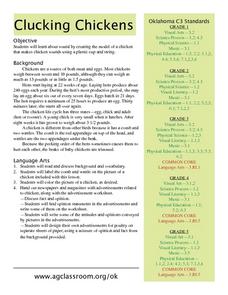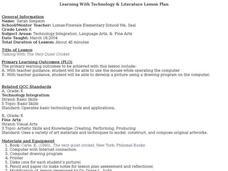Curated OER
Flipping Butterflies: Triadic Colors and Symmetry
Second graders create symmetrical butterfly wings. For this symmetry lesson, 2nd graders observe butterfly wings and create their own. They make both sides symmetrical and mix primary colors to make secondary colors.
Curated OER
What is an Initial Public Offering (IPO)?
Students learn the difference between primary and secondary stock markets. Obviously, students explain that it is difficult, if not impossible, for individuals to get shares of an IPO at the offering price.
Curated OER
A Box Of Crayons
Students draw self-portraits on die-cut crayon patterns after hearing the poem "A Box of Crayons" in this Art instructional activity for the elementary classroom. The instructional activity is ideal for celebrating Martin Luther King...
Curated OER
Scary Stuff!
Fourth graders interview community members for a "newspaper". They design a business brochure, write a disappearing ghost story, and experiment with mono-printing. They experiment with a variety of materials, tools, equipment, and...
Curated OER
Clucking Chickens
A comb, wattle, and beak are three characteristics that describe a chicken. Your class can explore the life of a chicken through reading, art, movement, and music. Using a plastic cup and string, they'll create a pretend chicken that...
Curated OER
Agriculture is a Cycle
Students explore cycles in nature. In this cross curriculum agriculture lesson, students define "cycle" and research weather and planting folklore. Students make a bracelet in which individual colored beads represent the many "cycles" of...
Curated OER
Sunny Sunflowers
First graders, after assessing how plants grow in relation to light, create models of sunflowers within a game to help them remember their science lesson. In addition, their visual models serve as a demonstration of photo tropism in...
Curated OER
Energy Efficiency Ambassadors
Definitely for high schoolers, this lesson is an open-ended exploration of energy efficiency. Groups of two to three junior environmental engineers design an experiment to test for efficiency. They prepare a full lab report and poster...
Curated OER
Treaty Trail: Crossing the Bitterroot Mountains
Students examine art and primary documents that depicts the Native Americans' crossing of Washington's Bitterroot Mountains to arrive at the Spokane Council. Students investigate and compare maps and other historical materials determine...
Curated OER
Element of Color
Students develop their own original color by using only primary colors, black and white. As a class, they review the warm, cool, secondary and tertiary colors. To end the lesson, they examine the effect of different colors on the human...
Curated OER
Understanding Freedom: Catching "The Spirit of '76"
Sixth graders complete activities about colonial history through an examination of art from the American Revolution period. In this history and art lesson, 6th graders define an iconic image, sing the song 'Yankee Doodle,' and analyze...
Curated OER
Combining Technology with Literature
Students develop a picture using the computer with an education computer program. In this technology lesson plan, students draw a picture on the computer based on a book that they have read.
Curated OER
Learning with Technology and Literature
Students practice their reading comprehension by utilizing computers. In this education technology lesson, students utilize a drawing program such as Microsoft Paint to draw pictures based upon the story they read, The Very Quiet...
Curated OER
Very Hungry Caterpillar
Students read "the Very Hungry Caerpiller" by Eric Carle and create their own caterpillers using the same art techniques found in the book in this excellent early elementary lesson plan. Included with the lesson plan is a vocabulary list...
Curated OER
Very Hungry Caterpillar - Tissue College
Students create tissue collages using paints, tissue paper, and glue in this cross-curricular art/literature lesson based upon the artwork of Eric Carle. Emphasis is placed upon the term collage and practicing collaging techniques.
Curated OER
Pattern Value Portraits with Light
Students use the elements of art and principles of design to explore value. In this color value lesson, students use the portrait of a a face to help them understand color value, tints, shades and tones.
Curated OER
Seeing through Touch
Students explore solid objects using touch. In this art lesson, students are blindfolded and given a 3 dimensional object to explore with their hands. After the object is removed, students draw what they think the object looked like....
Curated OER
Mud Puddles And Bubbles
Students create muddy foot prints, "paint" with their feet, and explore the uses of bubble mix in this three-part lesson for the early-elementary classroom. The three activities can be used separately, or adapted depending on the...
Curated OER
We Are Alike, We Are Different:A Focus on Japan
First graders develop a connection with students in a first grade classroom in Japan. They begin to develop a curiosity about Japan--the landscape, the people, and their culture, while developing an understanding of the Five Themes of...
Curated OER
Preposition Man
Students practice using prepositions by writing on the tracing of a human. In this parts of speech lesson, students create a giant poster using the tracing of a classmate's body and fill in the outline using prepositions in places where...
Curated OER
Social Effects of WWII on SC (Pt. 3)
Fifth graders examine the impact of World War II on South Carolina. In this American history instructional activity, 5th graders analyze primary documents that include political cartoons and advertisements that were published in South...
Curated OER
Mondrian, Math, and Amazing Colors
Students study geometric shapes, lines, and the primary colors as they create Mondrian-like art prints.
Curated OER
Design Motifs and Eggs
Students create an Easter egg that displays at least one secondary color, one primary color, and one motif of design.
Curated OER
Couch Potato or Inertia Victim?
Sixth graders how primary research is carried out. They design a simple survey questionnaire to interview people about their week average television watching time. They analyze the results and write a report based on the information.
Other popular searches
- Art Lessons Primary
- Art Lessons Primary Penguins
- Edible Art Lessons Primary
- Art Lessons Primary Easter
- 3d Art Lessons Primary
- Art Lessons Primary Fruit
- Winter Art Lessons Primary
- Maori Art Lessons Primary
- Visual Art Lessons Primary
- Art Lessons Primary Tiger
- Art Lessons Primary Water
- Art Lessons Primary Victoria

























